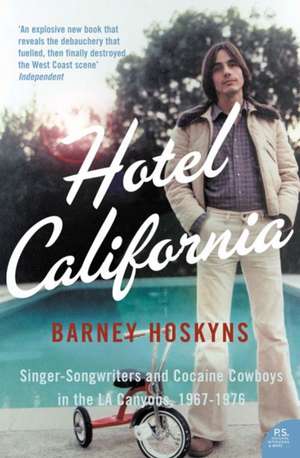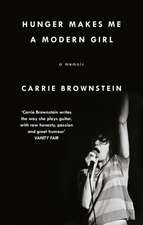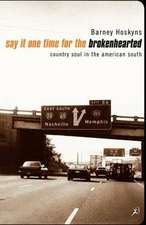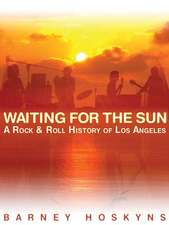Hotel California
Autor Barney Hoskynsen Limba Engleză Paperback – 17 iul 2006
| Toate formatele și edițiile | Preț | Express |
|---|---|---|
| Paperback (2) | 94.59 lei 3-5 săpt. | +11.12 lei 10-14 zile |
| HarperCollins Publishers – 17 iul 2006 | 94.59 lei 3-5 săpt. | +11.12 lei 10-14 zile |
| Wiley – 30 apr 2007 | 125.95 lei 3-5 săpt. | |
| Hardback (1) | 212.03 lei 3-5 săpt. | |
| Wiley (TP) – apr 2007 | 212.03 lei 3-5 săpt. |
Preț: 94.59 lei
Nou
18.10€ • 18.95$ • 14.98£
Carte disponibilă
Livrare economică 15-29 martie
Livrare express 04-08 martie pentru 21.11 lei
Specificații
ISBN-10: 0007177054
Pagini: 416
Dimensiuni: 129 x 196 x 27 mm
Greutate: 0.27 kg
Editura: HarperCollins Publishers
Locul publicării:United Kingdom
Textul de pe ultima copertă
--Alan Light, author of "The Skills to Pay the Bills: The Story of the Beastie Boys"
"Through hundreds of interviews conducted over the last dozen years, Hoskyns methodically chips away at the era's artifice and ego-driven mythologizing, revealing a creative landscape that was less stardust and golden than it was green with greed and white with cocaine residue."
--Erik Himmelsbach, "Los Angeles Times Book Review"
This book is a remarkable look at one of the most dramatic, creative, and revolutionary settings in American popular culture: the Los Angeles popular music scene from the late 1960s to the late 1970s. Drawing on extraordinarily candid firsthand interviews Barney Hoskyns has conducted over more than three decades, "Hotel California" takes you on an intimate tour--from the Sunset Strip to Laurel Canyon--of the creative and personal lives of the legendary songwriters, superstars, and producers who made the music that everyone listened to. You'll read things you've never read before about such fascinating, complex people as Joni Mitchell, Neil Young, Jackson Browne, Glenn Frey, Mama Cass Elliot, James Taylor, Linda Ronstadt, David Geffen, and many others. Packed with riveting anecdotes and sharp musical insights, "Hotel California" captures the amazing results of brilliant creative collaboration and the dark side of fame, wealth, and unbridled ambition. It is a story of rise and fall like none other, and you won't be able to put it down.
Notă biografică
Recenzii
Joni Mitchell; Neil Young; Jackson Browne; James Taylor; "Tapestry"-era Carole King; Crosby, Stills and Nash their songs really did seem special then and, to a surprising degree, remain so now.
Influenced by the way Bob Dylan's success in the 1960s gave young songwriters permission to say anything they wanted in their lyrics, and created an audience that eagerly awaited such daring writing, they moved toward the intimately confessional. They were uncommonly good at it, often ruefully melancholy, and they scored million-selling hits.
Hoskyns looks at the time and place that spawned the singer-songwriters and their friends and lovers - the counterculture-friendly, surprisingly rustic and (at the time) affordable hillside canyons separating Los Angeles' busy basin and oceanfront communities from its equally busy suburban Valley. Laurel Canyon, especially, but also Topanga Canyon and some others. Some of the book's subjects were born in Southern California and some came from elsewhere; some started writing in California and some brought their established careers with them.
"It was very different from the Tin Pan Alley tradition, where guys would sit down and try to write a hit song and turn out these teen-romance songs about other people," Henry Diltz, a photographer friend of the singer-songwriters, is quoted as saying.
The results - Mitchell's "Ladies of the Canyon" and "Both Sides Now," Young's "Old Man" and "Heart of Gold," Browne's "For a Dancer," Taylor's "Fire and Rain," King's "It's Too Late" and many more - constitute a golden era of American songwriting.
It's one that might not come again in terms of quality and cultural impact. And the possibility that it was a peak seems to be dawning on their core audience of aging boomers, as well as publishers. Hoskyns' book follows by just a few weeks another on the same subject, Michael Walker's "Laurel Canyon."
This takes its title from a song by one of the biggest acts to emerge from the milieu, the Eagles, who covered material from the singer-songwriters in addition to composing their own. They are not the best examples of the scene's artistry but certainly of its commercial success. Hoskyns uses the term "rocklite" to describe their sound.
A British journalist and critic whose previous books about American music include the superb "Strange Days, Weird Scenes, and the Sound of Los Angeles" and "Across the Great Divide: The Band and America," Hoskyns is knowledgeable about his subject. He loves delving behind the hits and the superstars to see who else was making valuable music in L.A. during the period.
In doing so, he points out that the canyon's "organic" singer-songwriters weren't the only thing happening in L.A., nor was their approach unchallenged by others. As a result, "Hotel California" has some lively and intriguing ideas about the shortcomings of confessional songwriting - a preoccupation with self-reflection - that gives the book intellectual weight.
An L.A. singer-songwriter who was a contemporary of the others - Randy Newman - has proven long-lasting precisely because he wasn't confessional, Hoskyns observes. "Using third-person characters - or singing in character - Randy's songs were suffused by irony, often stunningly funny." He also has praise for the satirically political work of Frank Zappa, and for the exploration of "the darker side of the California dream" pursued by Tim Buckley and Tom Waits.
For that matter, Neil Young had as much of a dark side as an idealistic one, Hoskyns points out - he once recommended that his record label sign an aspiring songwriter named Charles Manson (be-fore the Tate-LaBianca murders).
In their personal lives, the canyon singer-songwriters pract
















